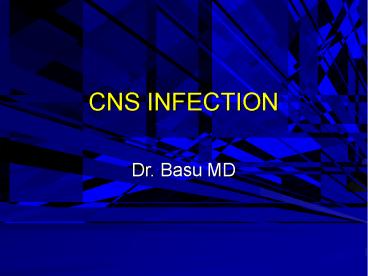CNS INFECTION - PowerPoint PPT Presentation
Title:
CNS INFECTION
Description:
CNS INFECTION Dr. Basu MD CNS INFECTION Meningeal Infection: meningitis Brain parenchymal infection { encephalitis} How we will proceed ? Route of CNS infection ... – PowerPoint PPT presentation
Number of Views:1589
Avg rating:3.0/5.0
Title: CNS INFECTION
1
CNS INFECTION
- Dr. Basu MD
2
CNS INFECTION
- Meningeal Infection meningitis
- Brain parenchymal infection encephalitis
3
How we will proceed ?
- Route of CNS infection
- Meningitis
- Bacterial
- Viral
- Fungal
- Brain parenchymal Infections.
- Viral encephalitis
- Spongiform encephalopathy
- Abscess
- Rabies
4
How infection enter the CNS ?
- HAEMATOGENOUS SPREAD.
- DIRECT IMPLANTATION TRAUMA, NEURAL TUBE
DEFECT. - LOCAL EXTENTION MIDDLE EAR, SINUS Infection
- VIA PERIPHERAL NERVE RABIES
5
Meningitis
- LEPTOMENINGITIS Meningitis
- Topics of individual diseases
- Etiology
- Morphology
- Investigation
- Clinical
6
LEPTOMENINGITIS Meningitis
- Definition
- Inflammation of the LEPTOMENINGES AND
SUBARACHONOID SPACE (CSF). - Types
- ACUTE (PURULANT) MENINGITIS
- ACUTE LYMPHOCYTIC ( VIRAL ) MENINGITIS
- Fungal
- CHRONIC MENINGITIS
7
Lab diagnosis CSF
Investigations Pyogenic Meningitis Viral meningitis
Glucose Very low Normal
Pressure increased Slightly increased
Protein High High
Cells Increased Neutrophils Moderately increased Lymphocytes
Culture Often positive Negative
8
ACUTE (PURULANT) MENINGITIS ETIOLOGY
- NEONATS Escherichia Coli, GROUP B STREPTOCOCI.
- CHILDREN gt 6MONTHS H. INFLUENZAE AND
STREPTOCOCCUS PNEUMONIAE.
9
ACUTE (PURULANT) MENINGITIS ETIOLOGY
- During Epidemics and most common in adults
Neisseria meningitidis. - Adult S. pneumoniae, Listeria monocytogenes.
- Following Surgery Staphylococcus aureus.
10
Opaque meninges due to exudates
Neutrophil in subarachonoid space
11
Complications sequel
- Edema can lead to herniation and death.
- Resolution of infection may be followed by
adhesive arachnoiditis fibrosis ( in basal
meninges) Obstructive hydrocephalus. - If cerebral meninges is involved communicating
hydrocephalous occur.
12
CLINICAL SIGNS
- Clinical signs may include
- Headache,
- Neck stiffness (from irritation of spinal nerve
roots), - Fever, and clouded consciousness.
13
- TOPIC
- Viral Encephalitis
14
Viral Meningitis Aseptic meningitis
- Meningoencephalitis If Viral meningitis is
associated with parenchymal Infection.
15
Viral Encephalitis
- CNS involvement may be localized or Generalized.
- Clinical Fever, head ache.
16
Viruses that can cause encephalitis
- Rabies virus
- Herpes simplex I virus encephalitis
- HIV encephalitis.
- Toxoplasmosis (infection)
17
Eosinophilic Negri body, as seen here in a
Purkinje cell in hippocampus.
Rabies
18
Herpes simplex virus I
- Produce hemorrhage and necrosis
- Involve temporal or frontal lobe
19
HIV INFECTION Symptoms
- Progressive Disease
- AIDS-Dementia complex
- Vacuolar myelopathy of spinal cord
- Most common cause of Dementia In the Young adult
(now-a-days) in the HIV endemic areas. - Micro Multinucleated giant cells.
20
Toxoplasma infection
- Can cause retinitis in new born.
- Develop calcification in brain.
- Can cause brain abscess.
21
Fungal meningitis
- Aspergillus Vasculitis and hemorrhage.
- Cryptococcus Involve Virchow robbins
space---soap bubble lesion.
22
Toxoplasmosis ring lesionClassical for abscess
Cryptococcus-soap bubble lesion
23
Chronic Meningitis
- Caused by
- Mycobacterium Tuberculosis
- Cryptococcus Neoformans
- Treponema pallidum
- Brucella.
24
Mycobacterium Tuberculosis
- Seen in AIDS with atypical mycobacterium
- Involve basal surface of brain basal meningitis.
25
Meningeal Syphilis
- May involve spinal Meninges produce thickening.
- Produce meningeal fibrosis and secondary
Hydrocephalous.
26
Brain Abscess
- Spread
- Hematogenous
- Contiguous
- Direct Face and nasal sinus, otitis media.
- Patient with Right to Left shunt are higher risk
of Brain abscess.
27
Morphology of abscess
- Localized collection of neutrophils.
Ring like shadow on CT
28
Clinical Features and Complications
- Fever
- Increased Intracranial Pressure
- Focal Neurological Deficit.
- Complications
- Brain Herniation
- Rupture of the abscess in the subarachnoid Space
- Subdural Empyema
29
Thank you !!!































